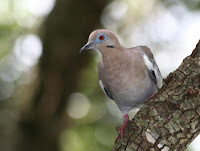Even as I sit outside and write, wildlife happens.
Earlier, as I was busy moving old blog posts over to this site I heard the distinctive "B" song of an eastern screech owl,
Megascops asio. It's a haunting, falling tone; really, quite unmistakable and a little bit spooky. Then, I heard the "A" song, a melodious trilling.

These (relatively) little owls (8-9 inches long with wingspans of 21-22 inches) are quite common in central and southeast Texas, and their range overlaps with the western screech owl subspecies through the middle and southern parts of the state.
Screech owls are active only after sunset and eat the usual owl fare: rodents like shrews, mice and rats, but also bats and birds. They'll even snag large insects on the wing, and have been known to eat fish, crawdads and scorpions.
At a work gathering at the Parrie Haynes Ranch the year before last, one of our video producers took a recording of screech owl calls and a PA system into the woods.
Some of my colleagues who accompanied him told me that half a dozen of the small owls flew down around them and perched in trees around the clearing in which they stood.

Clever boy that I am, tonight I hopped right over to
The Owl Pages, scrolled down to the eastern screech owl recordings, and started playing them on my computer. After about two minutes, Tam stuck her head out to tell me dinner was ready.
As I got up to go inside, I heard a clatter above my head. It sounded as if something was running across our patio roof. I looked up in time to see a large, brownish bird flying back into the yard.
A screech owl had flown under the porch, into the light, and then circled back into the night. The clattering I heard was its wingtips beating against the underside of the roof.
Cool.
I sense a fun evening coming on in a week or so ... something that involves sitting out by the fire ring with red lights and a laptop and my 8-year-old.
In other newsIn other news we've had buckets of rain, again. This time it was courtesy of Tropical Storm Erin, which made landfall just north of Rockport early Thurs. morning. The creek is flowing, and -- I couldn't help noticing today -- it's awfully pretty as it sparkles beneath the junipers and oaks in the late afternoon sun.
What is a "wet-weather creek?" Well, it's an intermittent stream. A sometimes -its-there, sometimes-its-not watercourse. The Edwards Plateau is a karsty kind of place, and a lot of our streams sink right through the porous limestone (and through caves and crevasses) into the Edwards Aquifer. Our neighborhood is smack-dab in the recharge zone for the aquifer, so it's no surprise that some of our creeks disappear almost as fast they appear.
This phenomenon makes for some lovely juxtapositons, like the prickly-pear cactus in the middle of the stream pictured above.

As I was leaving my office this afternoon I walked over to the wildscape garden that grows just outside the entrance to my building. There I was startled to find a grasshopper roughly the size and color of a canary.
It was clutching the stalk of a Turk's cap and it was so large, and so bright, that at first I thought someone had put a toy there as a joke. And then it moved.
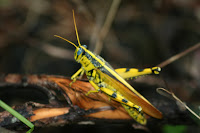
Naturally I had to get pictures. I've posted them to
BugGuide.net -- a fabulous site -- and so far have this educated guess as to what it is: "One of the bird grasshoppers in the genus
Schistocerca."*
Speaking of wildscapes, that's something Tamara and I are giving some thought to. As I'm fond of mentioning, we have a great backyard.
There are a couple -- three -- non-native shrubs I'd like to see gone, but the laurel and oaks and ashe juniper are all healthy and beautiful. The oaks have a nice understory of brush that the birds really appreciate.
 Oh -- the owl's back.
Oh -- the owl's back. Two yards over it sounds like. Time to crank up the owl song. I'll just let it play as I type ... see what happens.
Anyhow. Wildscapes. Yeah, so we're studying-up on what we can do to make our yard even more wildlife friendly. A water garden is a sure thing. But does the English Ivy really have to come out?
A couple of nights ago we had our biggest backyard visitor to date: ol' brer 'possum. I surprised him, he surprised me. He fled up an oak tree and I grabbed the camera (
see the second photo on the page).
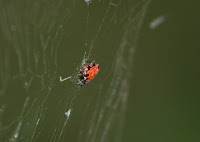
This morning as I was waiting on the cable guy, a brilliantly striped butterfly fluttered by. Turns out it was a zebra longwing (
Heliconius charithonia). One of the fascinating habits of these butteflies, also called zebra heliconians, is that they tend to travel a circuit or "trapline," following a particular route again and again as they gather food.
I found a red spiny orb weaver in the oak grove at the back of the yard two days ago. I think it must be that connection to my childhood, when I found these spiders so fascinating, but I just can't get over how cool it is to have three different color phases of this animal in the yard.
For the birdsI think I mentioned that we put two bird feeders up. The one with the mix of seeds has been quite popular, and not just with the birds. The suet/peanut mixture (probably the wrong time of year) has been visited infrequently, mostly by titmice and chickadees.
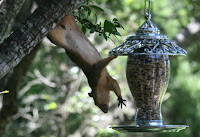
Jays, cardinals, Carolina chickadees, black-crested titmice, white-winged doves and wrens all come through daily. A particularly enterprising squirrel also has made a couple of runs at the feeder.
On day three, I took it down and swapped out the sturdy rope it was hanging from with 30-lb. monofilament. I also hung it farther out on a limb and away from the trunk of the tree.
The squirrel has been pretty frustrated since then.
I wrote "Carolina chickadee," (
Poecile carolinensis) but the birds I see here may in fact be black-capped chickadees (
Poecile atricapilla), or hybrids of the two. They all look about the same. One way to tell them apart is by their songs. Carolina chickadees have a four-note song, black-capped chickadees a two-note song.

The hybrids -- you guessed it -- invariably sing a three-note song.
These birds often will pick up a seed from the feeder and fly with it up to a nearby branch. "Tap-tap-tap-tap-taptaptap ..." the bird will hammer it open, then flit back down for another.
We'll call them Carolina chickadees for now. We're a bit south of the range of the black-capped, and smack-dab in the middle of the Carolina's summer range.
The cardinals have been fascinating to watch. There is one male adult and a fledgling that visit together fairly regularly. The fledgling, which will feed itself when dad's not around, will cheep "feed me" noises and shiver his feathers from a nearby branch when dad's on the feeder. The adult male dutifully takes him cracked seeds and puts them in his beak.
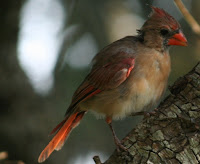
Cardinals are monogamous and typically mate for life. Males actually take on the majority of parental care, at least when it comes to foraging for the youngsters.
One theory is that because there is a sex bias among cardinals -- there are more males than females -- the males who have mated have to work hard to avoid "divorce." Does this mean China is in for a period of doting dads?
The owl, apparently, has thought better of a repeat visit to the porch. Oh well, another evening perhaps.
[I've since discovered this grasshopper is an Alutacea Bird Grasshopper, Schistocerca alutacea.]
 It is a succulent driven to succeed, and for the longest time, we just called it "the alien plant." In fact, we didn't know what it was. We did know that the plant thrives in the King William District of San Antonio.
It is a succulent driven to succeed, and for the longest time, we just called it "the alien plant." In fact, we didn't know what it was. We did know that the plant thrives in the King William District of San Antonio. Here's what the literature says about propogation methods for this plant: By dividing rhizomes, tubers, cormsor bulbs; from leaf cuttings; from herbaceous stem cuttings; from softwood cuttings; from seed; by simple layering; from bulbils.
Here's what the literature says about propogation methods for this plant: By dividing rhizomes, tubers, cormsor bulbs; from leaf cuttings; from herbaceous stem cuttings; from softwood cuttings; from seed; by simple layering; from bulbils. It's just not safe to keep them outside. In fact, the plant is highly toxic to all sorts of critters, including humans.
It's just not safe to keep them outside. In fact, the plant is highly toxic to all sorts of critters, including humans.
